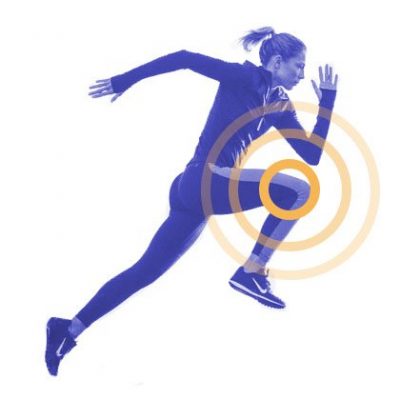Inner Thigh/Knee Pain
Adductor muscle sprain
When the muscles that move the leg inwards to the body’s centre are strained. The adductor muscles also move the body from side to side and assist in kicking and jumping movements. Symptoms are a sharp pain in the groin and inside of the thigh, swelling, pain when moving the legs together or raising the knees.
Inner (medial) Meniscus injury
An inner Cartilage (Meniscus) injury occurs when the cartilage of the knee joint (that helps to shock absorb) is damaged by twisting the knee or in combination with larger more traumatic knee ligament injuries. Unfortunately, the menisci can be slow to heal as their blood supply is very limited and usually requires surgery.
Outer Thigh/Knee Pain
Outer (lateral) Meniscus injury
An outer Cartilage (Meniscus) injury occurs when the cartilage of the knee joint (that helps to shock absorb) is damaged by twisting the knee or in combination with larger more traumatic knee ligament injuries. Unfortunately, the menisci can be slow to heal as their blood supply is very limited and usually requires surgery.
Knee osteoarthritis (OA)
Knee osteoarthritis (OA) is the breakdown of the knee joint cartilage, reducing range of motion and causes stiffening, swelling and pain. This is usually caused by poor walking/running biomechanics, exercise technique and jamming of the joint. Rheumatoid arthritis (RA) is an autoimmune form which occurs when the body attacks its own joint tissue by mistaking itself for attacking foreign pathogens. This causes cartilage loss and joint pain, instability and deformity. Knee pain while walking or running is the main symptom, a ‘crunching’ sound and thickening or swelling, with the joint becoming stiffer the longer it progresses, especially in the morning.
Iliotibial band syndrome (ITBS)
Occurs when the structure that connects the outer hip to the knee is irritated and inflammed, this can cause pain on the outside of the knee (direct irritation) or the inside of the knee (indirect change to knee function). This is called Iliotibial band syndrome (ITBS) and is an overuse issue when repetitive flexing and extending the leg is involved e.g cycling and running.
Back of Thigh/Knee Pain
Hamstring Muscle strain
Occurs when the muscles on the back of your thigh that helps flex the knee and extend the hip get irritated. Athletes are more at risk, especially in sudden stop and start sports. Symptoms include pain at the back of the thigh or knee, sometimes the sides of the knee, a “pop” sound, swelling, tenderness, sometimes bruising and discoloration on the back of the leg.
The posterior cruciate ligament (PCL) injury
This is when the ligament inside the knee that connects the thigh bone (femur) to the larger bone in the lower leg (tibia) is injured. Commonly occurs among athletes when they suddenly stops, turns or makes cutting moves, or jumps and lands awkwardly. Symptoms almost always feels like a “pop” or that their knee is giving way, followed by swelling and pain and often notice the knee is unable to continue exercise.
Under Knee Pain
Patellar tendon pain (jumpers knee)
Happens when the kneecap (patella) has too much stress force through it and the tendon that holds the kneecap to the tibia bone is damaged or irritated. Sometimes it can tear or come off the bone (avulsion fracture). Patellar tendon pain (jumpers knee) is caused either by too much jumping, running, or cycling, or due to a sudden activity that causes it to twist. Symptom start with pain and tenderness underneath and behind the kneecap. There will be pain with knee flexion and extension, as well as gait especially when going downhill. Other symptoms include swelling around the knee joint and reduced knee range of motion.
Above/Front Knee Pain
Quadriceps muscle sprain
Occurs when the quad muscles that connect the hip to the kneecap get irritated. These muscles are used for many movements, including walking, running, cycling, kicking, and jumping. Each muscle helps in direction-support based on its angle on the front thigh. A quad strain feels like a sharp pain on the front inner/middle or outer of the thigh or above the kneecap, followed by weakness and limping in the affected leg, and swelling. Often the pain begins at the top of the leg and radiates down to the knee.
The anterior cruciate ligament (ACL) injury
This is when the ligament inside the knee that connects the thigh bone (femur) to the larger bone in the lower leg (tibia) is injured. Commonly occurs among athletes when they suddenly stops, turn or makes cutting moves, or jumps and land awkwardly. Symptoms almost always feel like a “pop” or that their knee is giving way, followed by swelling and pain, and often notice the knee is unable to continue exercise.
Patellofemoral pain syndrome (PFPS or anterior knee pain syndrome)
Is an overuse condition often occurring in teenagers, manual laborers and athletes, and is typically caused by the wearing down, roughening or softening of the cartilage under the kneecap. Patellofemoral pain syndrome pain is felt in the front of the knee and around the kneecap, at first when jumping, running or climbing stairs, then later the knee might buckle or swell and stiffen until there is constant pain, even at rest.
WHAT CAN I DO ABOUT IT?
Treatment involves a variety methods based on your activity, biomechanics, whether it has come on quickly or gradually and what the root cause is. Here are some treatment modalities that are used to treat knee and thigh problems. Its important to make sure the diagnosis is right, and that’s where we come in



